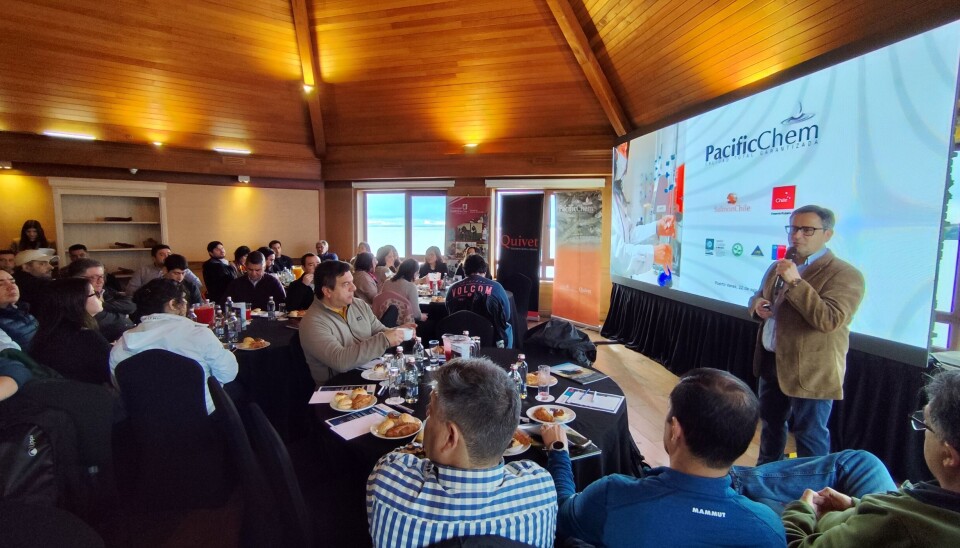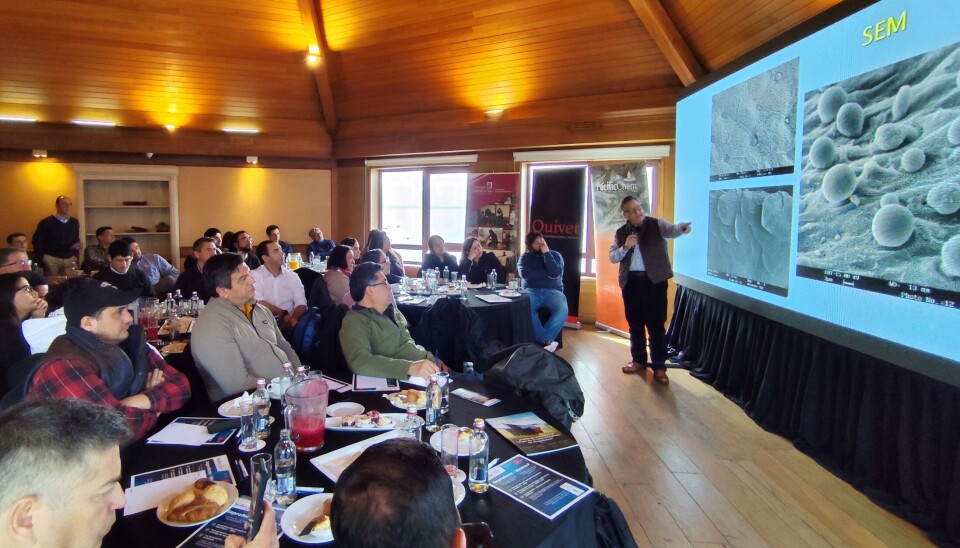
Highlighting the benefits of Neutra-F and its use in freshwater salmon treatments
This new development will provide a solution to one of the major problems in salmon farming when treating saprolegniasis with formalin, or Saproform, as marketed by Pacific Chem.
With a large turnout including representatives from production companies, authorities from the Ministry of Health and the Ministry of the Environment, Sernapesca, Directemar, SAG, suppliers, and academics, Pacific Chem laboratory held a working breakfast titled "Regulations on the use of formalin: How to comply with values below 1.0 ppm of formaldehyde in effluent? Update on the status of Saprolegniasis in Chile".
On this occasion, Felipe Amtmann, manager of the Southern Zone of the Pacific Chem Group of Companies, announced the resolution by the authority that allows the use of the product developed by Pacific Chem, Neutra-F, a formaldehyde neutralizer from Saproform that ensures proper treatment of fish against saprolegniasis, protecting their health and welfare while ensuring that production centers can use the product with a focus on fish health, according to the recommendations defined by veterinary doctors based on sanitary conditions and incidence of mycosis, thus ensuring that residual formaldehyde concentrations are always below the new threshold established by the Authority, which states that "under no circumstances shall effluent discharges or residues exceed 1 ppm formaldehyde concentration".
"We had the opportunity to discuss with professionals from the production and fish health areas of various salmon farming companies, as well as with authorities and academia, which was the most valuable part of this event. Additionally, we were able to confront positions, clarify concepts, and share information and objective data about what we are facing. In relation to the above, particularly in how we take care of the environment and ensure that there are no hazardous residues associated with saprolegniosis in the waterways in Chile," highlighted the Veterinary Doctor.
In the same vein, the professional noted that this complements very well with the challenge that Pacific Chem has set for itself. "We want to produce therapeutic solutions for fish health and at the same time meet environmental requirements, safety for people, and animal welfare. We have achieved this with a development involving a series of public and private entities, which currently allows us to be operational in various fish farms, from the Biobío Region to Magallanes with the implemented solutions and working together with the areas of environment, health and occupational safety, production".
For Amtmann, this points to the new relationship that veterinary pharmaceutical laboratories must have with the salmon industry. "It is necessary to accompany them in the processes, become part of the challenges and constantly propose solutions, even 'bold' ones that go beyond what is currently required, but which in the medium term will have additional regulations. We know that this is the standard that the Chilean salmon farming industry currently has."

Saprolegniasis
At the event, Dr. Ricardo Henríquez, head of the Laboratory of Biotechnology and Aquatic Pathology at the Institute of Animal Pathology of the Austral University of Chile, revealed the most important aspects of the etiological agent and its impacts on salmon farming, noting that the greatest impact of the disease is seen during smoltification, in presmolt and smolt, where all the changes that occur at this stage predispose the fish to both primary and secondary fungal infection.
“According to data from Sernapesca, regarding freshwater treatments, mycosis accounts for almost 80% of the treatments, followed by flavobacteriosis, atypical furunculosis, and other diseases. As of June this year, treatments have reached 70%, and among the products used for these treatments, the active ingredient Formaldehyde accounts for 65%, while Bronopol is used in 32.5% and Chloramine T in 2.2%. Meanwhile, the region where treatments for mycosis are mostly carried out is in Los Lagos, with 40.24%, while in Araucanía it is 32.15%,” displayed the academic from UACh. “The impact of saprolegniasis is managed by salmon farming through chemical baths that are efficient in countering mycosis. However, salmon farming has a vision of providing this high-quality protein for the nutrition of people on the planet in a sustainable way. And that vision is what motivates both academia, as well as the public and private sectors, to develop science and technology-based initiatives to mitigate the effects of this pathology. That is the great task that suppliers have, to sustain salmon farming in our country,” pointed out Dr. Enríquez.
In the researcher's opinion, the development carried out by Pacific Chem is a differentiating element within the industry. “It is a serious company, which bases all its development and entrepreneurship on regulations, and with that foundation, it meets all the requirements to understand the impacts of these products, mitigate those impacts, and comply with current legislation. In this way, seriousness and transparency are given to the overall production process.”




















